December 11th, 2020
MVP Development – 15 Steps to Build an Effective MVP

Table of contents
Since you come here for specific steps to build a Minimum Viable Product (MVP), I assume that you already know what it is. You’re not in the mood to read half a page of its definition, are you?
If you’re looking for the facts and a step-by-step explanation of how we build MVPs at CSHARK, you’ve come to the right place. Let’s dig straight into it!
But if you need an introduction to MVP development and want to know its perks and pitfalls, you’ll find them in the further part of this article.
What you’ll learn from this article?
- How to build an MVP effectively? This is what you came for – the MVP development process in 15 smooth steps.
- Building an MVP vs. the pitfalls. We’ll help you spot all the red flags and how to deal with them so they’re no longer an issue.
- What are the benefits of building an MVP? The advantages of MVPs are a no-brainer, but maybe some of them will be unexpected?
- What is a Minimum Viable Product (MVP)? We won’t forget about a must-have in any MVP article, a definition for all the newbies.
How to Build an MVP Effectively?
Below are 15 hard-won lessons that we’ve learned at CSHARK during 8 years of working with our clients.
Save your tears (and money) for another occasion – these 15 steps will accelerate the agile development of your successful MVP!
Effective MVP Development in 15 Steps
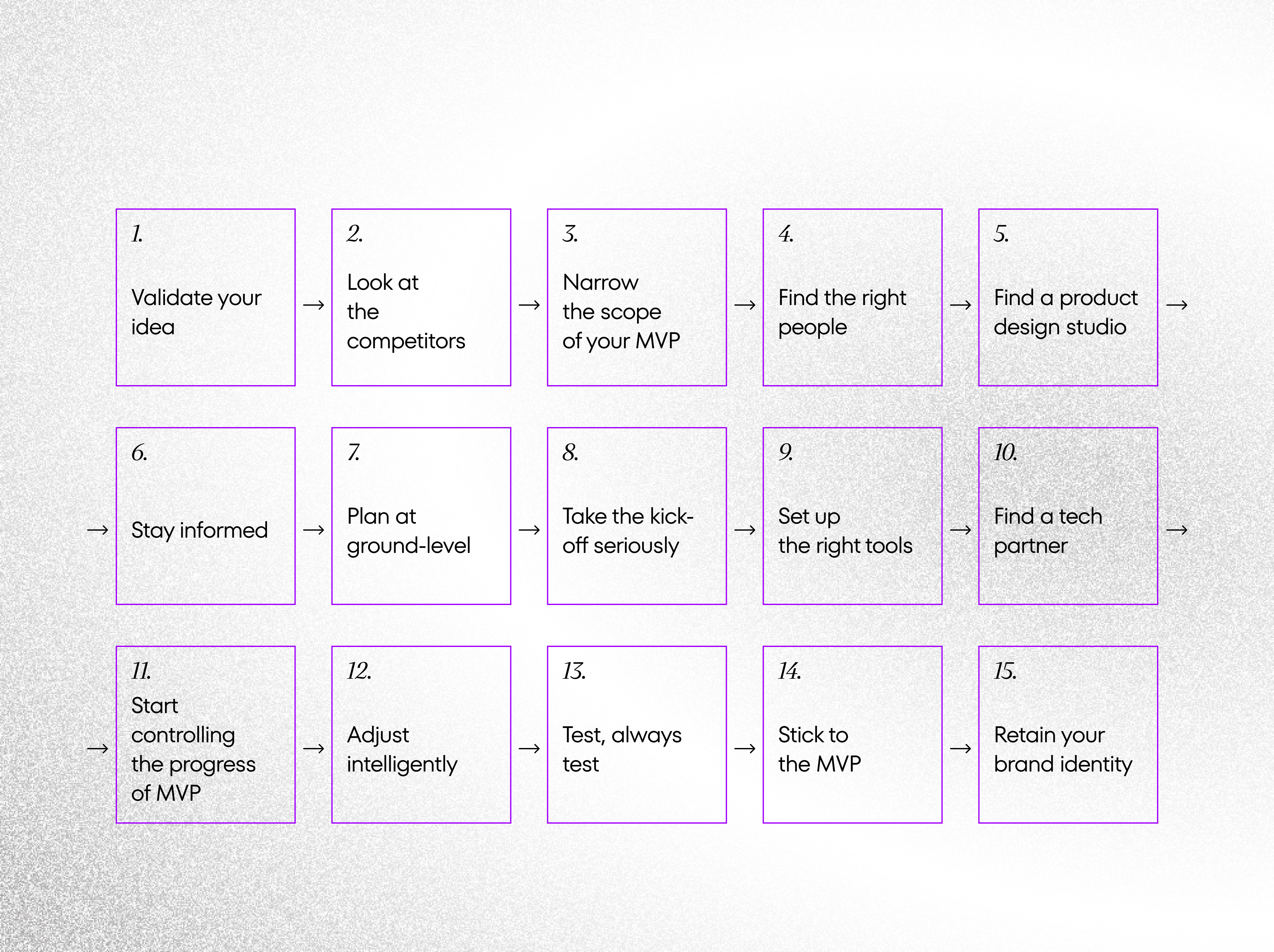
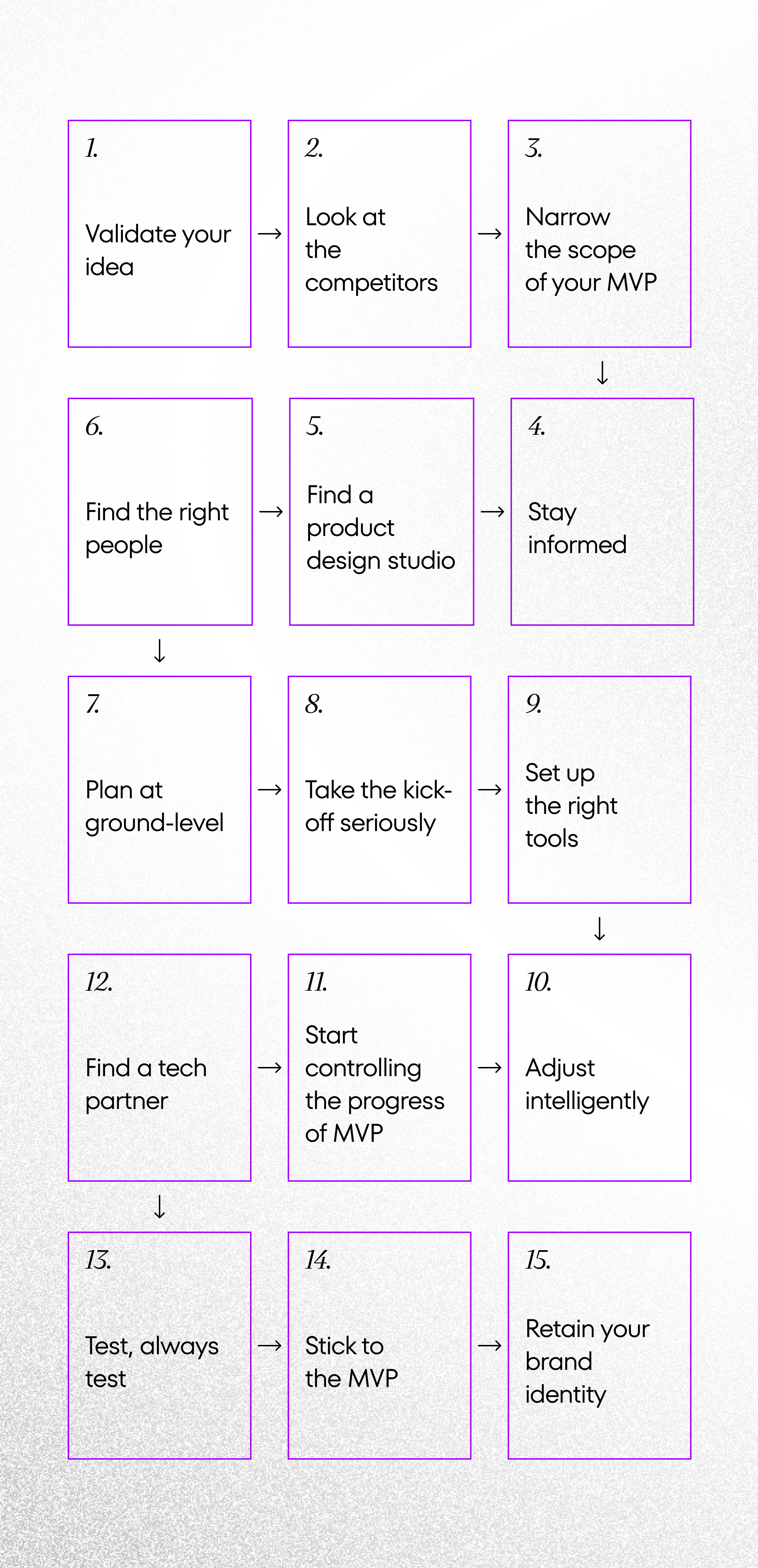
1. Validate your idea (repeatedly)
The “idea” is always the most thrilling part of agile product development. It’s when you’re the most driven and enthusiastic. You’ve found a significant problem to solve! All you need to do now is build the solution.
Right?
Not quite.
Your idea might be new, but it might not be practical or even needed. There are plenty of startups that solved a problem people didn’t need to get solved!
In industry, sometimes we call such startups ‘problem architects’. These people would design a pain to fit their solution to build a Minimum Viable Product by force.
Focus on your target market to build an MVP people want
Approach your target market and tell them about your idea. Don’t be afraid of someone stealing your concept – the chances of that are very slim. They don’t have a development team tucked away in their basement, nor the millions of dollars needed to pay their salaries…
Conduct interviews and discover whether your solution is helpful. Confront difficult questions immediately. Better to know your idea’s weaknesses sooner rather than later, right?
Read more: MVP Software Development – How to Succeed at Creating Digital Products?
2. Look at the competitors
Many startup entrepreneurs claim that “they have no competition”.
All it means is that they didn’t look hard enough… Someone will have tried to solve the same issue before in a different way.
Investigate their product. See if their attempt worked, and what you can learn from their experiences.
Idea validation can save you the cost (and heartbreak) of building a poorly conceived MVP. Don’t rush through this step! Make it a non-negotiable part.
3. Narrow the scope of your MVP
Think big, but start small.
Development teams sometimes have trouble remembering what the “M” in “MVP” stands for. Control the urge to tack on extra functions. Aim for something achievable yet effective.
The Minimum Viable Product isn’t supposed to be pretty or comprehensive.
It’s a base around which you can grow the rest of the product. It’s there to collect feedback from product users. And you? You can watch trends and establish more use cases.
Packing extra features into the MVP will increase your technical debt. Beware: it may introduce product or system limitations down the road!
Remember that a bloated MVP is often the result of a weak product owner or development process that a committee rules. Strong leadership and a well-defined scope of features will keep the size of your MVP manageable. Bonus: it’ll also get it out the door faster.
Discover how to build successful products smoothly
READ CASE STUDY4. Find the right people (and do it fast)
Do you have the resources to build an MVP that matches your vision?
Imagine an ideal situation: you have product designers and software development specialists ready to take your project by the horns. But this isn’t always the case…
You could always build an internal development team, but that takes months (or sometimes even years).
It’s not a deal-breaker, though. You can still partner with external teams to get the job done.
5. Find a product design studio
Firstly, the product design studio that will turn your idea into a workable concept. How? By conducting product discovery workshops.
Your new partner would break your idea down into a process that would help understand the user from a product manager’s perspective. Each step would prioritize user experience, thus increasing the MVP’s chance of success!
The design studio could then create a product sitemap and wireframes (in the case of a web-based solution). As the next step, they could prepare a low-fidelity version for user review.
Testing the strength of the brand
When you reach out to users at this point, you’re testing more than just the strength of your idea. You’re testing the strength of your brand.
This early concept will attempt to use as much of your branding as possible (or as much as you have). In this way, you can know if your key philosophy will resonate with customers.
Once this test is done and you have collected enough customer feedback, you can create a high-fidelity prototype of your product.
And for this, we’ll need a different type of partner to build an MVP…
Read more: PoC vs. Prototype vs. MVP – Which One is for You?
6. Find a tech partner
Look for a tech partner that’s more than just an order-taker.
You’ll surely rely on them for their tech expertise, enabling them to build an MVP from a technical background. But that’s not all.
They need to be willing to stand their ground to protect the development timeline and scope. And most of all, they need to keep what’s best for the product in mind. This means defending their approach when you request features or changes detrimental to the MVP.
Engage your tech partner from the beginning of your Minimum Viable Product development
Let the tech partner be a part of the product discovery process when trying to build an MVP effectively. This way, they’ll be able to create a project backlog from the high-fidelity design that the design studio created. The tech partner would also be preparing the architecture of your project and selecting the proper tech stack to build and maintain the project moving forward.
An ideal option?
Finding a tech partner that offers both software development and product design services.
The project’s design and development will be more closely coordinated – the team designing the product will be from the same company as the programmers and testers working on it.
At CSHARK, we conduct Discovery Workshops as a part of the digital product’s planning phase. We help you understand the entire development process from start to finish. We go through the details of what needs to be done to successfully deliver the project and provide accurate budget and timeline estimates.
7. Set up the right tools
Technology matters just as much as people when building an MVP.
The proper tools will help the team be more reliable and coordinate better. We generally break down these tools into 3 categories:
- Project management
You need a method of documenting the project plan as well as tracking responsibilities, timelines, and progress. JIRA and Monday are our project management tools of choice but feel free to use whatever fits your needs. It’s the place where all members go to refer to the backlog and submit user stories.
- Communication
You need an effective way for people to communicate, both in real-time and asynchronously (so relying on email is out!) in the process of Minimum Viable Product development. Your communication tool should allow coordinating meetings, discussing ideas and problems, and pinning of oft-used links. We like Slack, but again, the choice is up to you.
- Reporting
You need a reporting tool that can help you present important information in digestible chunks to the programmers and stakeholders. Your project management tool will sometimes have a sufficient reporting module, but you may need to use Excel, Power BI, or some other report-focused software.
STILL NOT SURE HOW TO BUILD AN MVP?
CHECK HOW WE DO IT8. Take the kickoff seriously
The MVP development project kickoff involves more than just saying “Get to work.” It’s a pre-game briefing.
A proper kickoff involves making sure everyone knows their roles and responsibilities. It involves reviewing the project scope and everyone’s part in it. It also covers the different tools that software developers will use.
The kickoff of your MVP is an excellent opportunity to set expectations for people’s schedules and preferred ways of communication. Don’t waste it!
When possible, conduct your kickoff meetings on-site and include all project members. Invite product stakeholders and subject matter experts.
9. Plan at ground-level
It’s easy for managers and/or product owners to draft a plan and just call it a day.
However, the MVP development plans you construct in your head may not match what it’s possible to do in real life…
Share your plan with the crew and break things down into sprints. Get their input on your proposed schedule and whether or not they think it’s workable. Adjust if necessary.
The key is to be ambitious yet realistic. If you make an MVP development plan that’s too aggressive, it’s going to fail and burn the team out in the meantime.
10. Stay informed
Your programmers should stay in close contact with you and with each other, so schedule daily standups during which you can discuss progress.
They don’t have to be long; 10-15 minutes should be enough, depending on the size of the team.
When building an MVP, establish a culture of communication in which you encourage people to share any complications as they arise.
11. Start controlling the progress of your MVP development
Software development is hardly a set-and-forget affair!
You have to track the progress throughout the sprint and make sure that the features function properly. Track risks and how changes will affect the timeline and budget.
Look beyond the current Minimum Viable Product and decide on the next feature set. But don’t do it in isolation. Confer with the product owner and programmers to see which new features will make the most sense for customers.
12. Adjust intelligently
No project plan ever survives contact with real life…
Even something as scaled-down as an MVP will experience delays and rescopes. That doesn’t mean you should automatically accept all changes.
Before editing the project plan, confirm the change with the rest of the development team. Does everyone agree? Why or why not?
Try to make small changes. Pick those that don’t affect the functionality of completed features and align with the development strategy.
Be sure to record the details of every change in the backlog. Get everyone (especially the stakeholder) to understand and accept the impact of the change before going with the flow.
13. Test, always test
Test new product features whenever they’re delivered when building an MVP. Test them at an early stage of development. Test them before moving to the next phase. Test after updating the production version. Test products before putting them on the market. Test products after putting them on the market. Test the bug fixes that you missed in your previous tests.
Test. Test. Test.
No software product will ever be 100% bug-free. But you can cut the number of bugs in your MVP through constant testing.
Also, prepare to respond quickly to bugs once customers discover them (and there will be bugs).
14. Stick to the MVP
We’ve been making this point throughout the article, and it keeps repeating because it’s essential. Stick to your minimum viable product.
Control any changes while building an MVP. Don’t alter the plan without good reason. Every change you accept will make it easier for “just one more change” to slip through…
Schedule product changes after the release, even if they seem like beneficial features. If the MVP works out, you’ll have plenty of opportunities to add these new features to the main product.
Besides, this is a better business decision! The revenue you get from the MVP can finance product expansions.
15. Retain your brand identity
Your MVP development has to be lean, but that doesn’t mean it has to be bland.
Make sure you capture the brand in the user experience of the product. Communicate your uniqueness through the aesthetics of the user interface or the product’s ease of use.
Even something as simple as the color of a button is enough to communicate personality. You should take extra pains to make sure it aligns with your intended brand image.
Building an MVP vs. The Pitfalls
Building a Minimum Viable Product (MVP) is a particular development process… And there are many ways to do it wrong. I listed some common mistakes below.
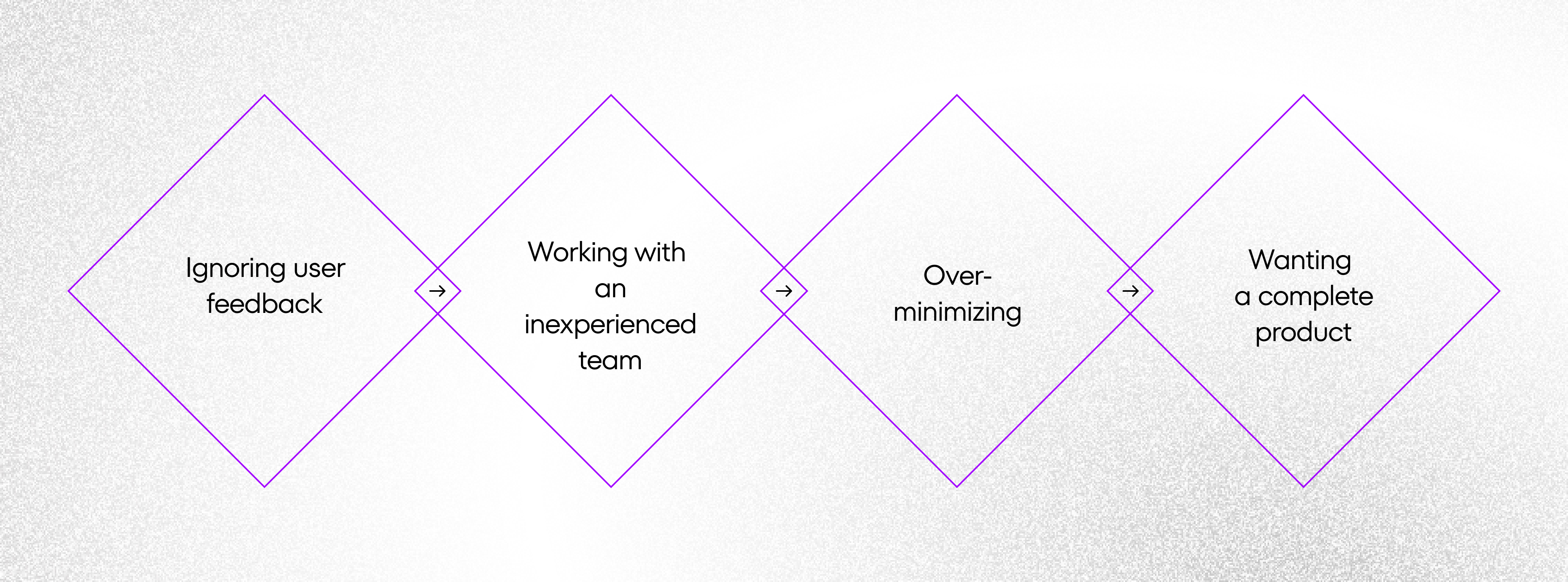
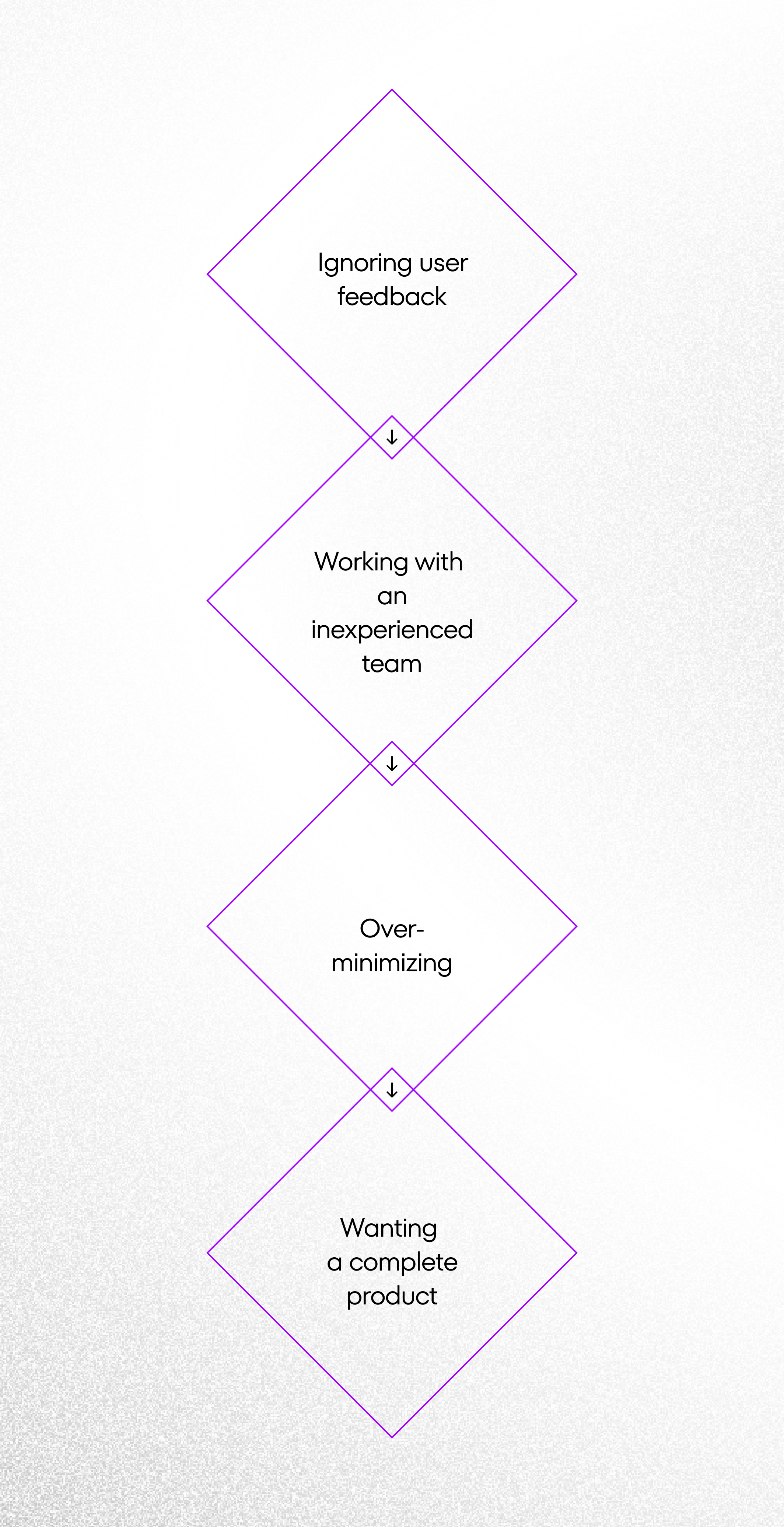
- Ignoring user feedback
The entire point of releasing an MVP is to use feedback to inform the other features.
You’re not going to collect or accept user feedback? You’ll act based only on your assumptions? Okay, so you may as well build the entire product in one go and release it. You’ll be wasting just as much development time and money.
- Working with an inexperienced team
Inexperienced development teams tend to overestimate their capabilities.
On top of that, they underestimate the effort required to test and build an MVP. This results in the project going over budget, leading to an even more rush to complete. In the article about the MVP price, we explained all the costs you should be aware of.
The result? An MVP that is late, expensive, and has poorly designed and implemented features.
- Over-minimizing
This is when you take the “minimum” in Minimum Viable Product too far…
In situations like this, you have cut down on nearly every feature and released a useless product. MVP should be valuable for users, but not weighed down by unnecessary features that slow down product development.
- Wanting a complete product
Many project owners believe that the MVP should be shiny and bug-free.
This is the exact opposite of what an MVP is. Remember: you’re building a basic product that’s functional enough to provide value to the user.
What are the Benefits of Building an MVP?
On a positive note, releasing a Minimum Viable Product instead of a full-featured product provides tons of benefits.
MVP Development – Benefits

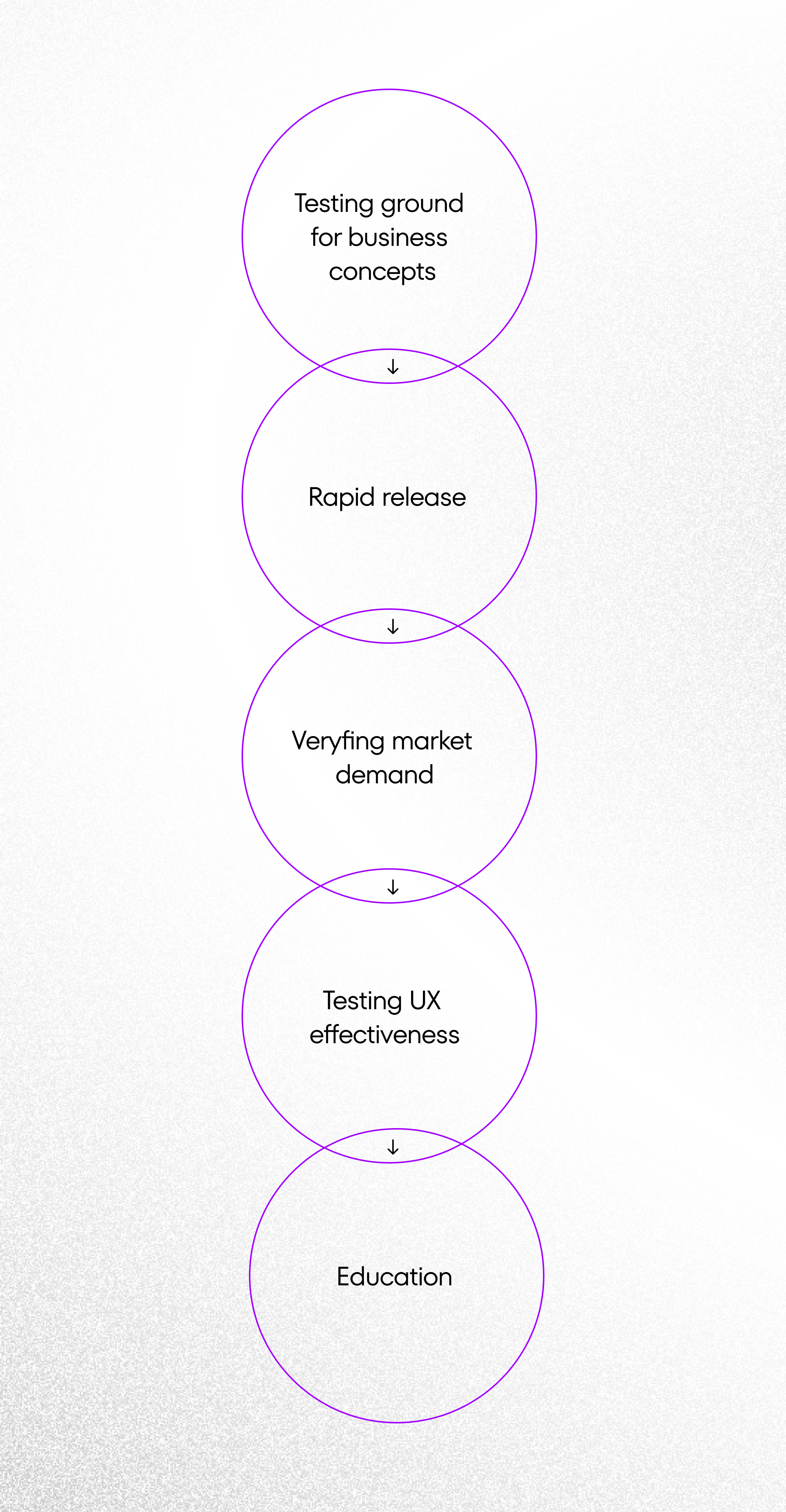
- Testing ground for business concepts
The MVP development process allows you to test new business concepts and see if they resonate with your target customers.
You’ll be able to tell who your core target market really is. How? Based on the most active users and how they interact with your product.
Once the MVP has gathered enough information, you’ll be able to choose which features to focus on next and adjust the product’s functionality to match user expectations. This continues until either the product is complete, or for its entire lifetime.
Read more: Minimum Viable Product is Not For You – It’s For The User. MVP Testing
- Rapid release
An MVP is a perfect strategy when you’re trying to catch a shifting or rapidly expanding market.
Many competitors are scrambling to develop their solutions, and the winner is often the first to make a usable product. Since you’re only focusing on the minimum amount of features, it should be faster to build, test, and release.
Just make sure that the early version of the product is actually usable. It doesn’t help if you release a shoddy product only to be first. Customers will notice and will ditch you in favor of the better offering.
- Verifying market demand
Your concept sounds great, but how to build an MVP that people want to use?
- Testing UX effectiveness
User experience is a large part of what makes a product “sticky”. And while you can (and should) hire UX designers and leverage their experience, the users themselves are the ultimate judges of usability and longevity.
When you release an MVP, you release it with the understanding that the UI and UX design will change over time.
Your Product Designers should gather as much user feedback as possible and refine the user interface to suit the user’s sensibilities. They may even be able to identify new opportunities to expand functionality and upgrade the product further.
Read more: The Battle of UX vs. UI Design: Looking Through Product Designer’s Eagle Eyes
- Education
Most people don’t like change.
Giving the ability to make an incremental, but small change takes them on a journey and opens up constructive conversations.
All transformation teams take time, and very often, it’s a lot better to start with an MVP rather than a revolution that will disrupt your business. That gives people time to adjust and reap benefits from chunks of functionality without the fear of overwhelming change.
What is a Minimum Viable Product (MVP)?
Don’t worry, I remember that I promised you a definition! Here it comes.
A Minimum Viable Product, or MVP, is an early-stage version of a new product with the least necessary features to perform its intended function. The production team would then add more functionality to the MVP over several development iterations, collecting and incorporating user feedback.
MVPs are commonly used in software product development. They’re helpful while creating business and commercial products and devices. There’s a simple rule that they need to adhere though; they need to provide business value.
Minimum Viable Product (MVP) or Minimum Lovable Product?
For seasoned software development teams and managers, a Minimum Viable Product seems to have gotten a bad rep over the last few years. They tend to see it as expensive and think that it leaves everyone with a bitter taste of compromise.
Some started to use an alternative term which is MLP (a Minimum Loveable Product). The reason is to emphasize the uncompromised lovability focus.
We hope we debunked some of the myths around MVPs. Hopefully, we provided more clarity to the concept and how to execute the process the right way!
Conclusion
As you can see, building a Minimum Viable Product is a very involved procedure. But it’s also a good thing. It increases the likelihood of your product being well-received and loved by the target users.
Just remember that as you collect and incorporate user feedback, your new product will grow. Not only in size and scope but also in popularity and profitability.
For more tips on how to build an MVP, check our guide linked below. Learn how we work with partners all the way from concept creation to the launch of the digital product. Let’s embark on this adventure together!
WANT TO LEARN MORE ABOUT OUR MVP DEVELOPMENT PROCESS?
REACH US